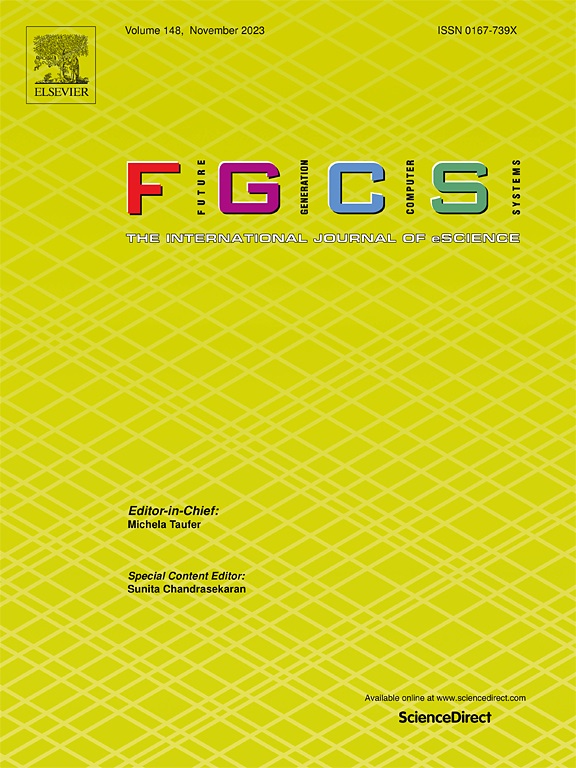Prediction model of performance–energy trade-off for CFD codes on AMD-based cluster
IF 6.2
2区 计算机科学
Q1 COMPUTER SCIENCE, THEORY & METHODS
Future Generation Computer Systems-The International Journal of Escience
Pub Date : 2025-03-20
DOI:10.1016/j.future.2025.107810
引用次数: 0
Abstract
This work explores the importance of performance–energy correlation for CFD codes, highlighting the need for sustainable and efficient use of clusters. The prime goal includes the optimisation of selecting and predicting the optimal number of computational nodes to reduce energy consumption and/or improve calculation time. In this work, the utilisation cost of the cluster, measured in core-hours, is used as a crucial factor in energy consumption and selecting the optimal number of computational nodes. The work is conducted on the cluster with AMD EPYC Milan-based CPUs and OpenFOAM application using the Urban Air Pollution model. In order to investigate performance–energy correlation on the cluster, the CVOPTS (Core VOlume Points per TimeStep) metric is introduced, which allows a direct comparison of the parallel efficiency for applications in modern HPC architectures. This metric becomes essential for evaluating and balancing performance with energy consumption to achieve cost-effective hardware configuration. The results were confirmed by numerous tests on a 40-node cluster, considering representative grid sizes. Based on the empirical results, a prediction model was derived that takes into account both the computational and communication costs of the simulation. The research reveals the impact of the AMD EPYC architecture on superspeedup, where performance increases superlinearly with the addition of more computational resources. This phenomenon enables a priori the prediction of performance–energy trade-offs (computing-faster or energy-save setups) for a specific application scenario, through the utilisation of varying quantities of computing nodes.
基于amd集群的CFD代码性能-能量权衡预测模型
这项工作探讨了CFD代码的性能-能量相关性的重要性,强调了可持续和有效使用集群的必要性。主要目标包括选择和预测计算节点的最佳数量的优化,以减少能耗和/或提高计算时间。在这项工作中,集群的利用成本(以核心小时为单位)被用作能源消耗和选择最佳计算节点数量的关键因素。这项工作是在基于AMD EPYC米兰的cpu和OpenFOAM应用程序的集群上进行的,使用城市空气污染模型。为了研究集群上的性能-能量相关性,引入了CVOPTS (Core VOlume Points per TimeStep)度量,它可以直接比较现代HPC架构中应用程序的并行效率。该指标对于评估和平衡性能与能耗以实现经济高效的硬件配置至关重要。考虑到具有代表性的网格大小,在40个节点的集群上进行了大量测试,结果得到了证实。在实证结果的基础上,推导了考虑仿真计算成本和通信成本的预测模型。该研究揭示了AMD EPYC架构对超级加速的影响,其中性能随着更多计算资源的增加而超线性增长。这种现象通过使用不同数量的计算节点,可以先验地预测特定应用场景的性能-能量权衡(计算速度更快或节能设置)。
本文章由计算机程序翻译,如有差异,请以英文原文为准。
求助全文
约1分钟内获得全文
求助全文
来源期刊
CiteScore
19.90
自引率
2.70%
发文量
376
审稿时长
10.6 months
期刊介绍:
Computing infrastructures and systems are constantly evolving, resulting in increasingly complex and collaborative scientific applications. To cope with these advancements, there is a growing need for collaborative tools that can effectively map, control, and execute these applications.
Furthermore, with the explosion of Big Data, there is a requirement for innovative methods and infrastructures to collect, analyze, and derive meaningful insights from the vast amount of data generated. This necessitates the integration of computational and storage capabilities, databases, sensors, and human collaboration.
Future Generation Computer Systems aims to pioneer advancements in distributed systems, collaborative environments, high-performance computing, and Big Data analytics. It strives to stay at the forefront of developments in grids, clouds, and the Internet of Things (IoT) to effectively address the challenges posed by these wide-area, fully distributed sensing and computing systems.

 求助内容:
求助内容: 应助结果提醒方式:
应助结果提醒方式:


